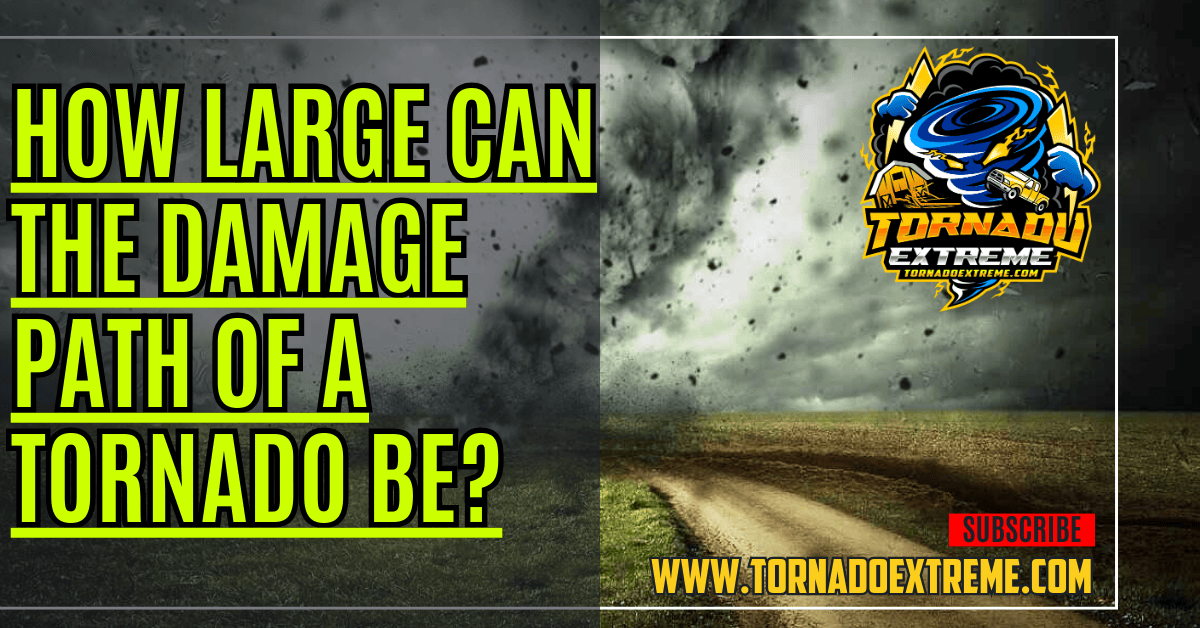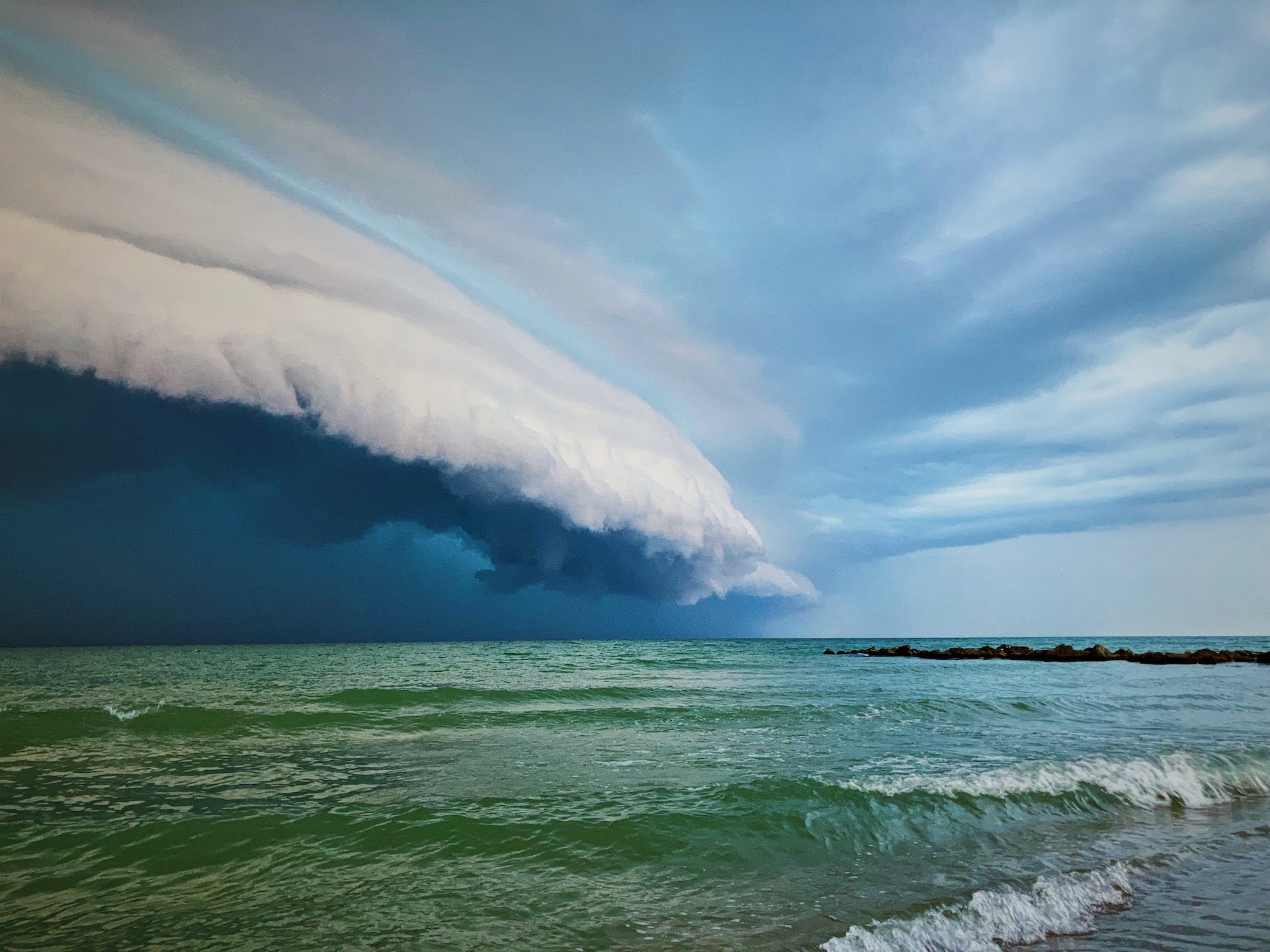Introduction: How Large Can the Damage Path of a Tornado Be?
The damage caused by tornadoes can vary greatly. Sometimes, only a few shingles are torn off, while in other cases, entire buildings are demolished. The Enhanced Fujita (EF) scale measures the intensity of a tornado and takes wind speed and associated damage into account. However, it’s not just structures that can be destroyed by a tornado; trees can also be uprooted, vehicles tossed around like toys, and debris hurled for miles, demonstrating the severe weather capabilities of tornado alley.
In addition to the structure factor, which suggests that well-built buildings may suffer little damage while weaker ones may have their foundations ripped from under them entirely, there is another way in which tornadoes wreak havoc: debris.
Objects carried by these winds can travel hundreds of miles away from where they started. When they land somewhere new, they cause destruction again, reinforcing the importance of a tornado warning system. Moreover, environmental factors like topography and land use play critical roles in determining how far-reaching this path will be.
For example, if a flat terrain is without any natural barriers such as hills or dense forests to slow down or alter the course of the funnel cloud’s movement then it will likely leave behind more damage than one would in an area with these aforementioned obstacles.
By better understanding these aspects of tornadoes’ destructive tendencies — how objects become lost as well as what speeds they travel at when thrown — world we gain insights on how to predict and mitigate its effects on communities and infrastructure.
Tornado Formation: How a tornado forms
Many forces converge to form a tornado — some of which meteorologists still don’t fully understand. The NOAA National Severe Storms Laboratory has made great strides in recent years regarding our knowledge about these monster storms and the conditions that produce them so frequently across our great nation but there’s still much we don’t know too.
A simple answer given by any old FAQ attempting to answer your questions might say something along the lines of this: “When warm, moist air meets cool, dry air, a tornado can form. These two different types of air don’t like to mix together. When they’re forced to do so by winds or other meteorological forces this creates instability in the atmosphere…” But it’s much more complicated than that.
For one thing, not all tornadoes even look like the stereotype we have in mind of a dark cone descending from the clouds. Some funnels are nearly invisible and some may appear as thin ropes extending down from stormy skies. It’s also worth noting that wind speeds inside these vortexes can reach up to 300 miles per hour (so it’s no surprise why roofs get blown off) and their tendency to spin can make them incredibly unpredictable — which is why predicting where one will touch down with any sort of accuracy remains an unattainable feat for the time being.
No matter what shape or size, the damage caused by a tornado can be life-altering. Powerful vortex winds can reduce towns to rubble in an instant.
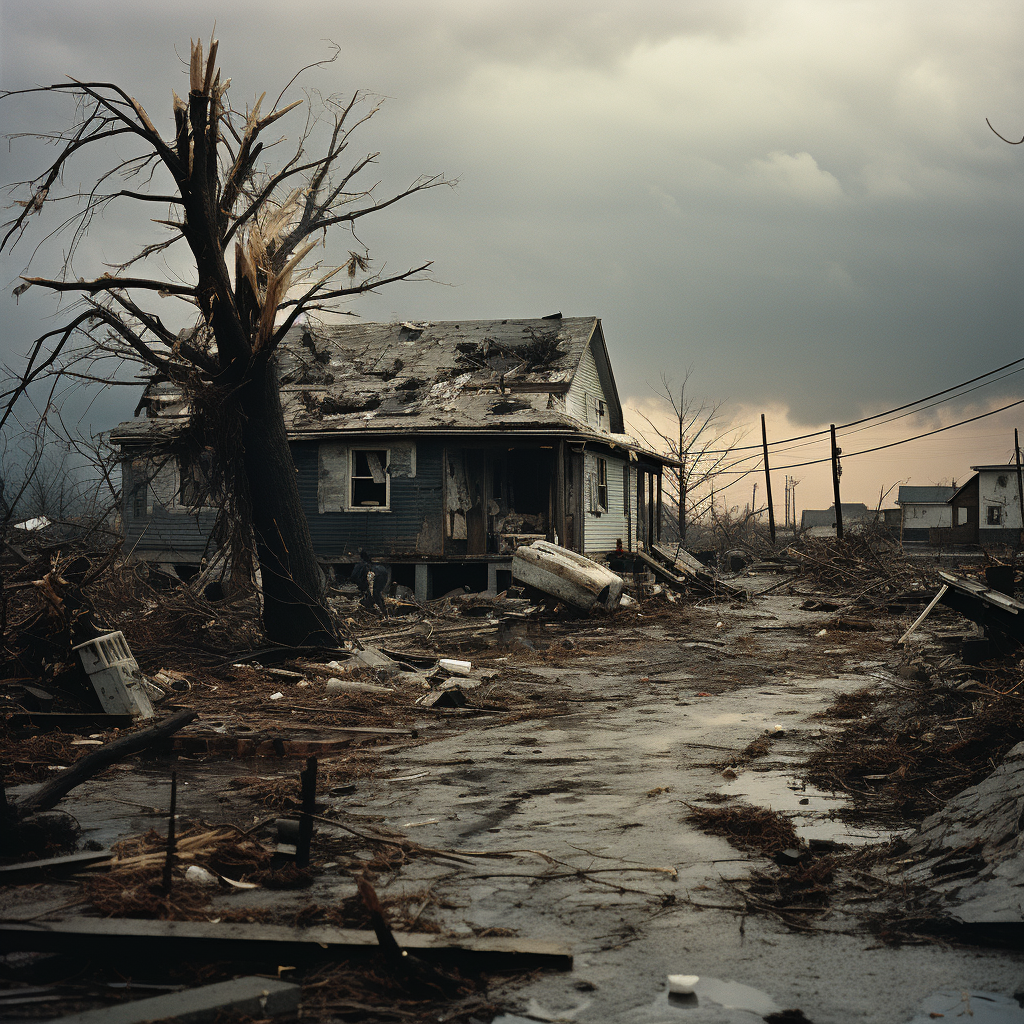
With Tornadoes, Size Does Matter
Yes, bigger tornadoes do cause more damage than smaller ones, a fact that has led to the development of systems to rate tornadoes based on their intensity. This isn’t some made-up theory— there’s science behind it. Bigger tornadoes have much stronger wind speeds and cover a wider area, which results in a wide path of destruction that can stretch for miles. Communities that are unlucky enough to be in the way of these larger storms are at a high risk for serious damage to homes, buildings, and infrastructure.
And even when the storm has passed and it’s time for recovery efforts, we’ll run into another obstacle: how massive the storm is. With a bigger path of destruction comes difficulty with reaching affected areas quickly and efficiently. The scale of wreckage also means local resources might not be enough for a full recovery. These findings only add more weight to the idea that being ready for large-scale tornadoes requires proactive measures and robust disaster management strategies.
Researchers who studied past tornado events found several approaches to mitigating these dangerous conditions. Unsurprisingly, one aspect is ensuring the public knows what to do during such an event. If people know how to respond during a warning, many injuries and fatalities can be prevented.
Building codes should also be adjusted so that structures can withstand powerful winds in areas that see frequent strong tornado occurrences.
Lastly (and obviously), communication systems need improvement in order for emergency response efforts to work properly during these huge storms.
See also: Green Sky Tornado: Why Does the Sky Turn Green?
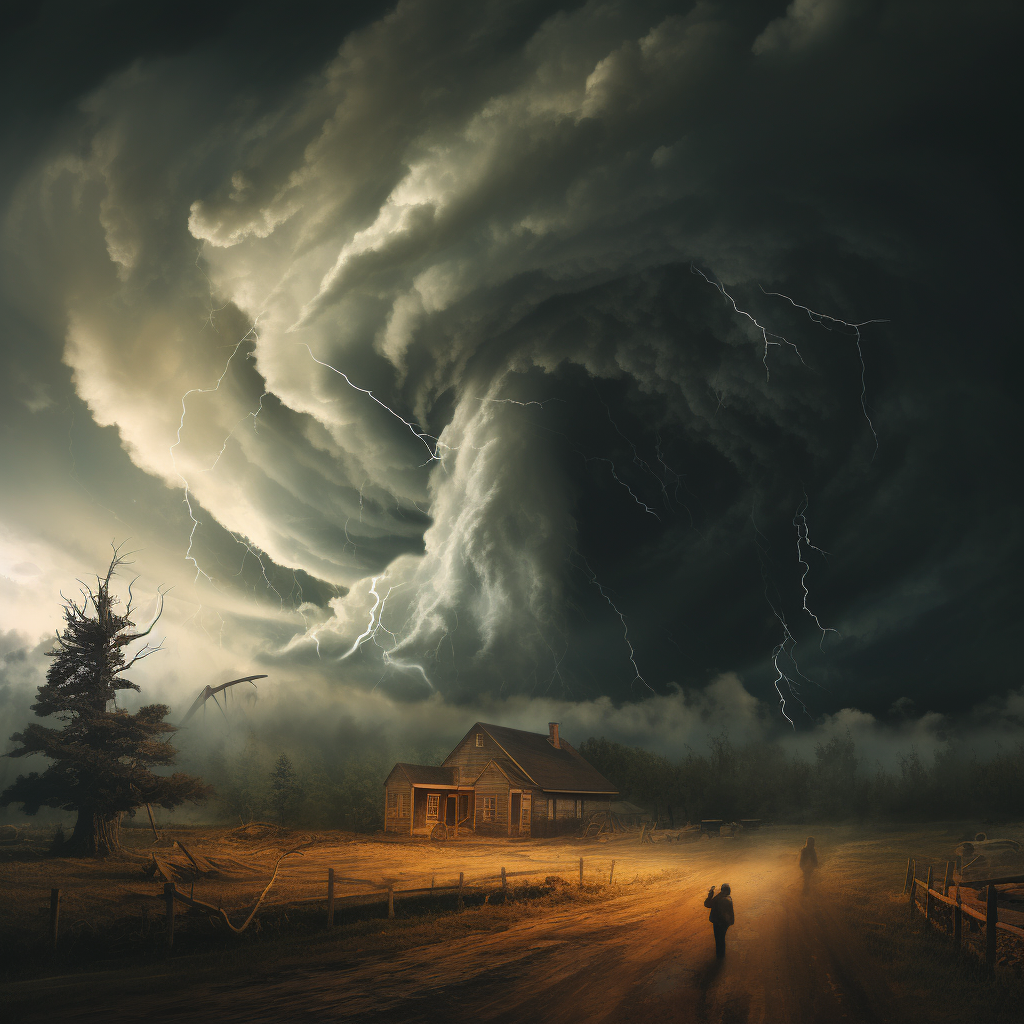
What Counts as a Tornado?
Meteorologists don’t play guessing games when they’re trying to determine if something was actually a tornado or not. They rely on certain characteristics instead.
To them, a rotating column of air from a thunderstorm cloud down to the ground defines what counts as an official tornado, as per the National Weather Service. The rotating column must also touch the ground.
When all of this happens, the tornado should have visible effects on its surrounding area, such as damage or debris.
Not all rotating columns—another name for funnel clouds—are considered tornadoes. These can’t be classified as such if they don’t touch the ground or affect anything in their path.
The distinction between a funnel cloud and an actual tornado is necessary to ensure proper recognition and classification of different weather phenomena.
A crucial factor in determining a tornado is its visible evidence. They are known to cause enormous damage and leave debris on sites they pass. This includes buildings that were destroyed, trees being uprooted, and objects scattered across the landscape.
However, not all rotating columns of air are tornadoes. Some may appear as funnel clouds but do not touch the ground or create any impact on their surroundings. Meteorologists differentiate them based on their impact and behavior.
When there’s an unstable atmospheric condition partnered with wind shear it creates funnel clouds. These look like a cone-shaped structure spinning rapidly from a parent cloud downwards. It shares similarities with tornadoes minus one major difference: it does not make contact with the ground.
Tornadoes only occur when these rotating columns of air touch land or water resulting in destruction.
How Do You Assess a Tornado’s Damage Path?
The path of destruction brought by a tornado calls for a systematic approach. Experts use aerial surveys, satellite imagery, ground assessments, and advanced mapping technologies to analyze how much damage was caused by the tornado. By documenting where debris fell, structural damage occurred and vegetation moved along its path can they estimate its intensity and categorize it accordingly using the Enhanced Fujita (EF) scale. Radar data at the National Severe Storms Laboratory may also be used to track how it moves real-time and predict potential areas that could be hit in order to save lives and minimize casualties.
Moreover, experts must consider different factors such as building construction, topography, and local weather conditions in order to understand how devastating the tornadic forces would be at varying degrees within its path. Buildings constructed differently react differently to these forces when they come into contact with them so analyzing its design helps researchers gain insights into what causes them to get damaged first when a tornado strikes..
The terrain can influence whether or not it touches down or lifts off intermittently too so knowing about this helps emergency responders develop strategies on what communities are most vulnerable and how long they need to be ready. Technological advancements in remote sensing that experts develop for accurately assessing a tornado’s damage path comes with more accurate data too which they refer to when issuing warnings, recommendations, or even evacuation protocols.
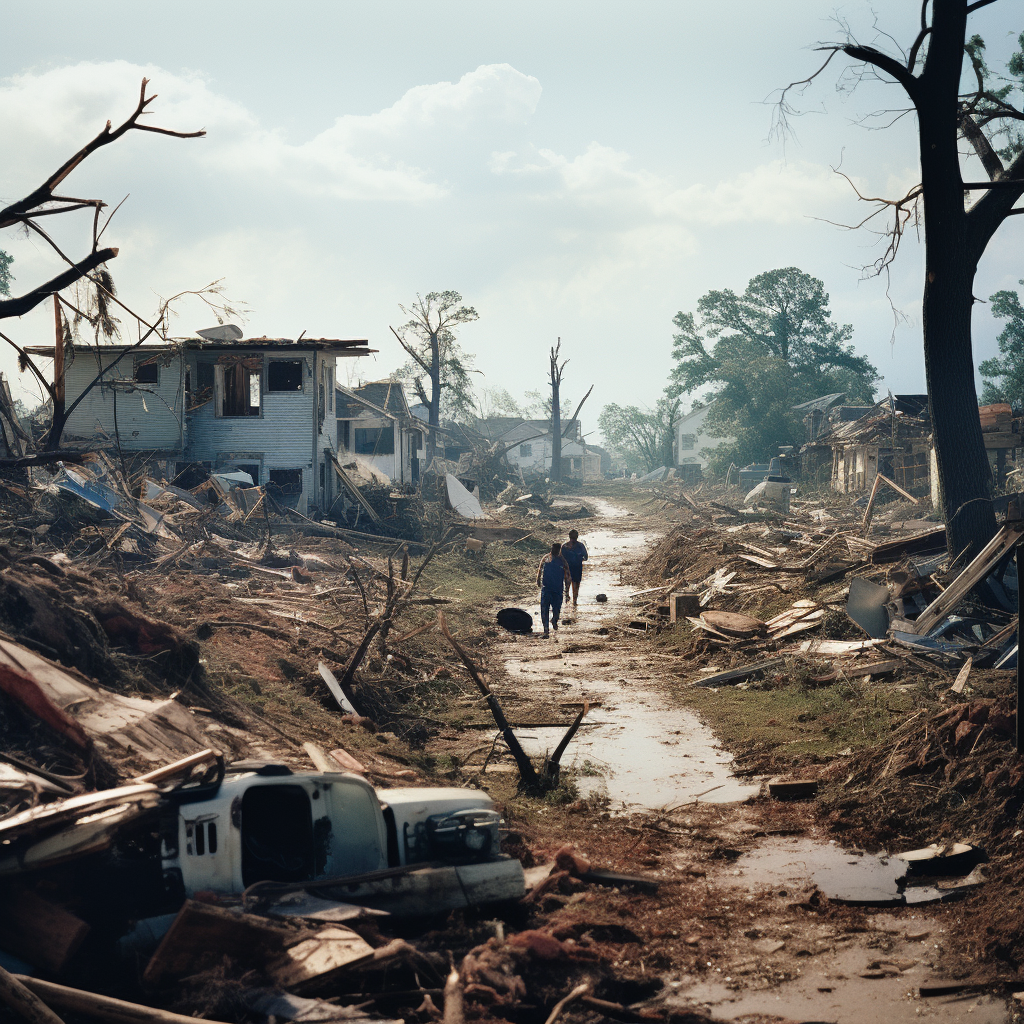
Case Studies: Examining historic tornado events
When it comes to understanding tornado size and power, there’s no denying that these natural disasters are forces to be reckoned with. Looking back at past events, we can see just how devastating they can be. The infamous Tri-State Tornado of 1925 holds the record for the longest path length in history, crossing three states and leaving hundreds dead in its wake. Meanwhile, the 2011 Super Outbreak birthed a staggering 362 tornadoes across the United States.
By analyzing these events and others like them, researchers have been able to gain valuable insights into their formation, behavior, and signs of occurrence. This information will prove to be invaluable in the long run as we aim to improve our early warning systems and disaster preparedness strategies. Though we may not yet understand all there is to know about disastrous twisters, every bit of knowledge helps when it comes to saving lives and keeping people safe from Mother Nature’s wrath.
There are several factors that influence where a tornado touches down and how much damage it causes. One of these is land elevation; hills or valleys can alter wind flow patterns, potentially causing a tornado to move erratically or dissipate entirely. Urban environments introduce additional complexities; buildings interrupt wind flow near the ground, which may disrupt a funnel cloud’s development or cause it to veer off course.
Furthermore, wind patterns within thunderstorms play an important role in dictating where a cyclone forms and which direction it moves in. When air flows towards areas with low atmospheric pressure (such as those surrounding violent storms), it rises rapidly in an updraft column (upward-moving air). As it ascends into colder regions of the storm system aloft, this moisture-rich air cools and condenses into visible clouds.
While scientists understand many elements of tornado formation — such as how supercell thunderstorms give rise to these tempestuous vortices — there are still some aspects that evade comprehension. For example, specialists have yet to figure out why only 30 percent of supercell storms seem to spawn tornadoes. Additionally, forecasting the duration and intensity of a twister is way beyond our current capabilities.
Tornadoes’ ever-changing size and strength make them nearly impossible to predict. This makes it rather difficult for people in their path to prepare. Understanding what leads to tornadoes becoming more dangerous is crucial if we want to find a way of protecting ourselves from them.
One key factor is the distribution or spread of atmospheric pressure. It directly affects how strong these things get, particularly when tornadoes occur, which can rapidly increase their intensity. When warm air rises from the ground below, it forms ideal conditions for powerful storms to form.
Further studies have shown that bigger weather patterns can also affect a tornado’s size and power. The wind, temperature shifts and other things at large scales are known for causing huge destructive ones in the US specifically. Tornadoes only scratch the surface of nature’s interconnectedness though; as researchers are still learning about storm behavior and why it happens in general.
Factors Affecting Damage Path: Environmental influences on path
Environmental influences are a critical factor when it comes to the damage path of a tornado. The topography of an area can shape the trajectory and destruction extent by impacting the speed and direction of the wind. Forests, valleys, and hills all play their part in this deadly dance. Urban areas on the other hand tend to get hit harder due to buildings serving as additional targets for fierce winds.
A large body of water can either take away or add to a tornado’s strength. Coastal regions in particular are at risk because they have that fuel source close by. It’s not fully understood why these environmental features interact with tornadoes like they do, so more research is needed.
When predicting where a tornado will go next and how much damage it might cause, considering its formation process is key. One huge aspect of this is wind patterns found within Earth’s atmosphere. A complex interaction between high- and low-pressure systems can give birth to these violent spinning masses.
Another one of the forces at play in shaping which direction a tornado takes is topography . Giant land structures like mountains have the potential to disrupt airflow which could stop it dead in its tracks or even weaken it completely.
Vegetation cover also plays its part in all this madness. Thick forests can put up barriers against upward motion within thunderstorms by impeding airflow near their surface. This may decrease any strong drafts necessary for intense tornadic activity.
Lastly, urban environments make everything even more complicated than it already is..
See also: Which State Has the Most Tornadoes and Why It Matters
Understanding Tornado Size and Power
Tornadoes come in a variety of sizes and strengths, which can make them incredibly difficult to predict and prepare for. Understanding the factors that contribute to tornado size and power is crucial in developing effective prevention and mitigation strategies. One factor is the distribution of atmospheric pressure, as it directly impacts the intensity of tornadoes. Warmer air at ground level can lead to buoyant updrafts, creating ideal conditions for powerful storms to form.
Researchers have found that larger scale weather patterns can influence the size and strength of tornadoes, which is vital knowledge when looking at how often tornadoes hit the U.S. For instance, certain wind patterns like strong jet streams or shifts in temperature gradients can play a significant role in the development of large and destructive tornadoes. This highlights the interconnectedness of different meteorological phenomena, underscoring the complexity behind understanding tornado behavior.
How Much Damage Do Tornadoes Cause?
Its no secret that tornadoes tend to be very destructive when they touchdown on solid earth again. Size and intensity are usually different depending on which one you look at, but nothing gets spared once they form up again.
The damage caused by tornadoes can be as small as knocking over a few branches or as big as completely leveling an entire town— yeah, it’s really not something you want to experience first hand. They have enough force behind them to tear through buildings like paper, lift cars off the ground and snap trees — all within seconds too.
But aside from a mere visual standpoint, this natural disaster has much more far-reaching effects than what meets the eye. The time and money spent on rebuilding can take years to recover from, sometimes never if there aren’t enough resources. Plus, all this destruction could leave scars on communities even without injury or death involved, a testament to the unpredictable nature of tornado season.

Exposure to Winds
We’ve discussed how heat plays a role in making these spins even stronger earlier in this piece, but winds do their own share of damage too once they’re up and running.
That being said, not all tornadoes are the same. Some come with strengths that can blow out windows and other fragile things in a building. But others are so weak that you wouldn’t even feel it — like going through a small gust of wind on your bike.
Another factor that decides how much havoc they wreak is the direction they’re moving in and what stands in their way. If they’re rolling uphill at your house, there’s no doubt that serious damage will occur rather quickly. The more time it has to batter things down, the more likely something will break or bend too.
Aside from learning how these monsters work, researchers also need to look at early warning systems and building designs if we want further protection against them down the road.
One aspect that often comes up when discussing the impact of a tornado on structures is the compromising of them. This happens when buildings or infrastructure become weakened or damaged during the event. The parts of these structures that are most likely to be compromised are things like walls, roofs or support beams. When these parts fail, there’s a very strong chance it will lead to collapse or significant damage. Being able to understand why tornadoes compromise structures is crucial in developing better building designs and methods to make our homes safer and stronger.
One major factor we need to consider is wind pressures and flow patterns in causing structural compromise, especially in areas identified by the National Weather Service as prone to severe weather. For those who don’t know, tornadoes create extremely high winds speeds that rotate in vortices. These rotating winds then push down on different parts of a building with varying pressure levels. By doing so, it creates an unbalanced amount of stress on each structure which then increases the risk of compromising them. On top of this, debris such as trees and rubble gets picked up by these powerful winds which could crash into walls and roofs, resulting in even further damage and weakness within each structure.
We also have to take into account how much damage a tornado path can cause by compromising structures, a concern that escalates during tornado season. The extent at which they take out buildings along their path helps us measure how severe their strength really is. From twisted trees uprooted from the ground to completely destroyed buildings, each wreckage offers information about how powerful something like this can be.The more we learn about these tornados, the easier it will be for meteorologists to develop a scale where they can rate their intensity and provide people time to evacuate their area before one hits
This analysis is especially important for classifying tornadoes using the Enhanced Fujita (EF) scale rating system. The EF scale, a common damage indicator, categorizes tornadoes into different levels based on their severity, ranging from EF0 (weakest) to EF5 (where violent tornadoes are categorised). A thorough understanding of a tornado’s impact allows scientists to assign an accurate rating, which in turn contributes to better forecasting models.
Moreover, this assessment provides crucial data for disaster response teams working hard to mitigate damage after a storm strikes, often in the aftermath of a tornado warning. It helps identify areas that require immediate attention in terms of search and rescue operations or debris removal efforts.
Compromising Structures
When it comes to buildings and tornadoes, one of the biggest questions is what happens to structures. Buildings or infrastructure can become weakened or completely demolished by a tornado. Walls, roofs, beams are some of the things that can be destroyed which could lead to a building collapsing. Understanding this process is crucial in making better building designs and construction methods.
One thing to understand are the wind pressures and flow patterns as it pertains to structural compromise. Tornadoes generate intense winds with varying pressures on different parts of a building. This uneven stress causes an unbalance on the structure which increases its chance of being compromised. With strong winds come debris that can be tossed around and impact walls and roofs causing them to fall faster than before due to their already weakened state. By studying these factors extensively, engineers will hopefully create a more effective design plan so that we don’t have lives lost so easily during these natural disasters.
Knowing how compromising structures are affected by tornadoes also shows us how far these natural disasters can reach in terms of damage paths along their route. The way that a tornado destroys infrastructure along its path gives us valuable data for knowing how vulnerable specific regions really are when it comes to this kind of disaster striking. By using patterns found in previous events, researchers can now look at ways they want to mitigate risk levels within regions based on how much damage has been done previously.
Assessing the Damage
Assessing the impact of a tornado can take many forms. One way is through a detailed inspection of damage using 28 indicators. This can be incredibly helpful in reducing risk for future events. By studying the path of destruction we are able to see what was affected and by how much. Sometimes the path extends miles and that’s just with varying degrees of devastation along the way.
Through careful analysis with these 28 indicators, researchers gain valuable insight into patterns that contribute to the severity of tornadic damage.
On another note, looking at specific types of damages tells us about its strength and characteristics. For example, twisted or uprooted trees gives us an idea about wind strength whereas demolished buildings gives us an idea on how strong it was structurally overall.
This information allows meteorologists to classify tornadoes based on their Enhanced Fujita (EF) scale rating system which provides data for them, disaster response teams, and urban planners. The scale works like this: EF0 being weakest while EF5 being strongest — where violent tornadoes are categorized). Understanding how wide the damage path typically is helps us minimize its impact on vulnerable communities and perfect our ability to forecast and prepare for future events.
A complete assessment will include a thorough inspection using 28 indicators in order to understand how extensive any given tornado’s damage could be? A typical approach would start by evaluating the tornado’s path — looking at how different areas were impacted differently. Another step is to understand what type of damage each location experienced specifically because this offers insights into intensity and duration… Twisted trees indicate weak winds but if it ripped buildings apart then we know it was bad! With enough data from these various factors (and more), experts will be able to better their forecasting models overtime… Allowing people like you and I more time to find safe shelter before disaster strikes!
Damage Assessment Methods: Techniques for measuring damage
Damage assessment methods have come a long way over the years, with various techniques now available for measuring damage caused by natural disasters such as tornadoes. Remote sensing allows aerial imagery and LiDAR data to be collected so you can accurately assess the extent of physical damage, crucial during tornado season. This means researchers and emergency responders will be able to create detailed maps of affected areas that give valuable insights into the severity and spatial distribution of harm.
Another method is crowd-sourced data collection through social media platforms — especially useful when the U.S gets hit by stronger tornadoes and rapid information gathering is needed. In recent years, it has become increasingly important for citizens to report and document damage through platforms like Twitter and Facebook, especially during tornado season when tornadoes hit the U.S. frequently.
This real-time information can supplement traditional assessment methods so we get a more comprehensive understanding of how natural disasters affect communities. By harnessing these innovative techniques, researchers and emergency management authorities will be better equipped at interpreting the destruction radius caused by tornadoes and also improve preparedness measures for future events.
See also: Which State Has the Most Tornadoes and Why It Matters
Community Resilience: Preparing for and mitigating tornado damage
To prepare for this catastrophic event, community resilience plays an incredibly vital role in both preparation and damage mitigation. Besides early warning systems & community shelters, empowering residents with knowledge & skills when responding to emergencies can be greatly beneficial in the long run. This could include first aid training, emergency planning workshops, and regular drills so that everyone knows how to respond when a tornado strikes.
On top of that, building resilient infrastructure can minimize the impact of tornado damage on communities. Constructing tornado-resistant buildings, reinforcing critical infrastructure such as power lines and water supplies, and implementing urban planning strategies that consider tornado risk can all contribute to reducing the overall damage caused by these natural disasters.
By investing in proactive measures that strengthen community resilience, we can reduce the long-term consequences of tornadoes and protect our communities from devastating losses.
Conclusion: Summarizing the impact of tornado damage
Overall, there is no denying that the impact of a tornado’s destruction is far-reaching. It goes beyond just physically tearing down structures & infrastructure because it also has long-term economic and emotional effects on affected communities, a situation often seen after tornadoes hit. The disruption of lives, livelihoods & irreplaceable personal belongings contribute to an overwhelming sense of loss and trauma.
It is also important to understand that the consequences of a tornado are more than what meets the eye. The psychological effects on survivors, the burden on emergency services and those who provide relief, as well as the environmental impacts all add intricacy to this catastrophe.
As we persist in studying and preparing for these types of natural disasters, it is crucial that we not only see the obvious damage but also make efforts to resolve problems that spread throughout a neighborhood once the tornado has passed.

